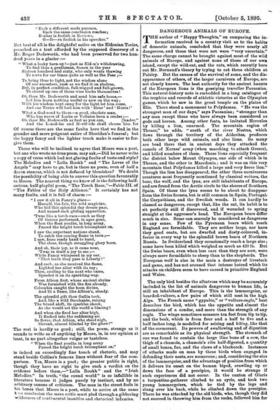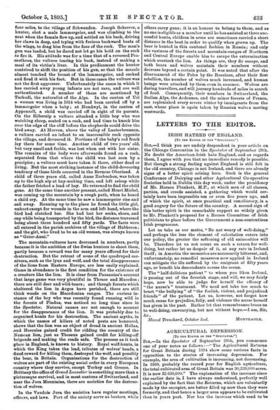DANGEROUS ANIMALS OF EUROPE.
THE author of "Happy Thoughts," on comparing the in- formation received in a country visit as to the habits of domestic animals, concluded that they were nearly all dangerous, and those that were not were "very uncertain." The same charge cannot be brought against most of the wild animals of Europe, and against none of those of our own island, except the wild-cat, and the rats, which recently bore out Mr. Burnand's theory by trying to eat three children at Paisley. But the causes of the survival of some, and the dis- appearance of others, of the larger carnivora of Europe, are not clearly known. The best authority for the ancient haunts of the European lions is the gossiping traveller Pausanias. This natural-history note is embedded in a long catalogue of the trophies and records of athletic victories at the Olympian games, which he saw in the great temple on the plains of Elis. There stood a monument to Polydamas. "He was the strongest man of our days," says Pausanias ; "stronger than any man except those who have always been considered as gods and heroes. Among other feats, he imitated Hercules by killing a lion, unarmed. The mountain region of Thrace," he adds, " south of the river Nestns, which flows through the territory of the Alderites, produces both other large wild animals, and also lions. So many are bred there that in ancient days they attacked the camels of Xerxes' army (when marching to attack Greece), and killed numbers of them. These lions especially frequent the district below Mount Olympus, one side of which is in Thrace, and the other in Macedonia ; and it was on this very mountain that Polyda.mas killed a large and very fierce lion." Though the lion has disappeared, the other three carnivorous creatures most frequently mentioned by classical writers, the bear, the wolf, and the lynx, are still inhabitants of Europe, and are found from the Arctic circle to the shores of Southern Spain. Of these the lynx seems to be about to disappear from the Swiss forests, but is still common in Spain, Portugal, the Carpathians, and the Swedish woods. It can hardly be classed as dangerous, except that, like the cat, its habit is to sit perfectly still if discovered, and if wounded to spring straight at the aggressor's head. The European bears differ much in size. Some can scarcely be considered as dangerous in any sense. Few of the Pyrenean bears which reach England are formidable. They are neither large, nor have they good coats, but are dwarfed and dusty-coloured, in- ferior in every way to the splendid brown bears of Northern Russia. In Switzerland they occasionally reach a large size ; some have been killed which weighed as much as 420 lb. But the Swiss bears, even when less rare than they are now, were always more formidable to sheep than to the shepherds. The European wolf is also in the main a destroyer of livestock and game, and has not aroused that intense hatred which its attacks on children seem to have caused in primitive England and Wales.
The only bird besides the albatross which may be accurately included in the list of animals dangerous to human life, is still an inhabitant of Europe. This is the lammergeier, or bearded-vulture, a few pairs of which still nest in the high Alps. The French name " gypaete," or "vulture-eagle," best describes the bird, which has the appetite and almost the dimensions of a condor, and more than the strength of any eagle. The wings sometimes measure ten feet from tip to tip, and the beak, which is from four and a half to five and a half inches long, is modelled for seizing and biting, like that of the cormorant. Its powers of swallowing and of digestion are as remarkable as its physical strength. The stomach of one was found to contain the large iliac bone of a cow, the thigh of a chamois, a chamois's ribs half-digested, a quantity of small bones, fur, and the claws of a blackcock. Instances of attacks made on man by these birds when engaged in defending their nests, are numerous ; and, considering the size of the lammergeier, and the advantage of position from which it delivers its onset on the human biped, crawling up or down the face of a precipice, it would be strange if such experiences did not occur. In the canton of Glaris a turpentine-gatherer climbed to an eyrie, and took two young lammergeiers, which he tied by the legs and slung over his back, while he climbed down the precipice. There he was attacked by the old birds, who, though they did not succeed in throwing him from the rocks, followed him for
four miles, to the village of Schwanden. Joseph Scherrer, a hunter, shot a male lammergeier, and was climbing to the nest when the female flew up, and settled on his back, driving her claws in deep, and trying with furious backward beats of the wings, to drag him from the face of the rock. The man's gun was loaded, but he dared not let go his hold on the rock to fire it. His attitude was for a time that of a reversed Pro- metheus, the vulture tearing his back, instead of making a meal of its victim's liver. In this predicament the hunter contrived to shift the position of his gun, so that the muzzle almost touched the breast of the lammergeier, and cocked and fired it with his foot. But in these cases the vulture was not the first aggressor. Unfortunately the cases in which it has carried away young infants are not rare, and are well authenticated. A number of these are mentioned by Tschudi, the naturalist of the Alps. In the canton of Uri a woman was living in 1854 who had been carried off by a lammergeier when a baby ; at Hundwyl, in the canton of Appenzell, a child was carried off in sight of its parents. On the Silberalp a vulture attacked a little boy who was watching sheep, seated on a rock, and had time to knock him over the edge of the cliff before the shepherds could drive the bird away. At Marren, above the valley of Lauterbrunnen, a vulture carried an infant to an inaccessible rock opposite the village, and devoured it. Portions of the baby's red frock Jay there for some time. Another child of two years' old, but very small and feeble, was lost when out with her sister. The remains of the body were afterwards found on a rock, separated from that where the child was last seen by a precipice ; a vulture must have taken it there, either dead or living. But the most striking instance of the child-devouring tendency of these birds occurred in the Bernese Oberland. A child of three years old, called Anne Zurbuchen, was taken op to the high alp at hay-making time, and left asleep while the father fetched a load of hay. He returned to find the child gone. At the same time another peasant, called Henri Michel, was coming up the mountain by a rough path, when he heard a child cry. At the same time he saw a lammergeier rise and sail away. Running up to the place he found the little girl, unhurt except for wounds in the arm and left hand, where the bird had clutched her. She had lost her socks, shoes, and cap while being transported by the bird, the distance traversed being about three hundred and fifty yards. The facts were all entered in the parish archives of the village of Habkeren ; and the girl, who lived to be an old woman, was always known as " Geier-Anni."
The mountain-vultures have decreased in numbers, partly because it is the ambition of the Swiss hunters to shoot them, partly because a reward was for many years offered for their -destruction. But the retreat of some of the quadruped car- nivora, such as the lynx and wolf, and the total disappearance of the lions from Eastern Europe, are less easily explained. -Game in abundance is the first condition for the existence of a creature like the lion. It is clear from Pausanias's account that large game was very plentiful in Thrace and Macedon ; there are still deer and wild-boars; and though forests which sheltered the lion in Argos have perished, there are still -thick woods on the Macedonian ranges. The curious in- stance of the boy who was recently found running wild in the forests of Pindus, was noticed no long time since in the Spectator. Natural causes are not enough to account for the disappearance of the lion. It was probably due to organised hunts for his destruction. The ancient myths, in which the names of killers of noted pests are honoured, shows that the lion was an object of dread in ancient Hellas, and Hercules gained credit for ridding the country of the Nemean lion, just as Theseus gained credit for killing-off brigands and making the roads safe. The process as it took place in England, is known to history. Royal wolf-hunts, in which the King takes the lead, tributes of wolves' heads, a :fixed reward for killing them, destroyed the wolf, and possibly the bear, in Britain. Organisations for the destruction of wolves are part of the existing social order in every European ,country where they survive, except Turkey and Greece. In Brittany the office of Grand Louvetier is something more than a picturesque survival, and in most cantons of Switzerland, and near the Jura Mountains, there are societies for the destruc- tion of wolves.
In the Vaudois Jura the societies have regular meetings, officers, and laws. Part of the society serve as beaters, while others carry guns; it is an honour to belong to them, and as no one is eligible as a member until he has assisted at three suc- cessful hunts, children in arms are sometimes carried a short distance in the beat in order to qualify when grown up. The bear is hunted in this cantonal fashion in Russia ; and only the vastness of the forests and mountain-ranges of Northern and Central Europe enable him to escape the extermination which overtook the lion. As things are, they do escape, and both bears and wolves maintain their numbers without decrease beyond a certain point. It was noted that after the disarmament of the Poles by the Russians, after their first rebellion, the number of wolves much increased, and human beings were attacked by them even in summer. Wolves are daring travellers, and will journey hundreds of miles in search of food. Consequently, their numbers in Switzerland, the Italian Alps, the Ardennes, and the minor forests of France, are replenished every severe winter by immigrants from the east, whose place is again taken by Russian wolves moving westwards.







































 Previous page
Previous page